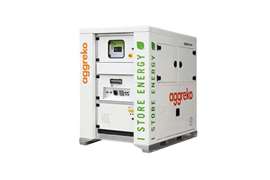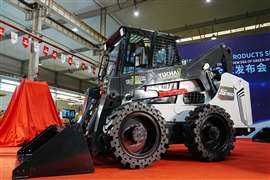Feature: Heavy lift cranes
10 November 2010
If there is one clear trend in the lifting sector, it is that cranes are getting bigger and bigger. This applies to crawler, all-terrain and tower cranes, and is in response to construction techniques using ever-larger prefabricated units, particularly in the power and petrochemical sectors.
This is most apparent in the crawler crane sector. Ten years ago there were only a handful of 1000 tonne capacity cranes at work around the world, and the one or two companies capable of manufacturing them regarded them as freakish one-off machines.
These days however, the latest generation of crawler cranes from industry leaders like Liebherr and Terex offer lifting capacities of 3000 tonnes or more, and even relative newcomers to the industry like China's Sany has a 1000 tonne crawler in its portfolio.
The largest capacity lattice boom crawler crane of this new generation is Terex's CC 8800-1 Twin, which offers a lifting capacity of 3200 tonnes. Put crudely, this machine comprises two CC 8800-1 cranes (1600 tonne capacity) 'bolted together' side by side with their controls integrated to produce a kind of permanent tandem lifter.
Operating in a similar range is Liebherr's LR 13000, a lattice boom crawler crane offering 3000 tonnes of lifting capacity, which is expected to be seen 'in the iron' shortly.
Currently undergoing testing meanwhile is Manitowoc's Model 31000, which is due to go into service in September following a year on the test pad.
The first two 2300 tonne capacity cranes have been bought by US-based Crane Rental Corp. and Bulldog Erectors Innovations on the machine include a variable position counterweight (VPC), while the machine is mounted on four individual crawler tracks for a 20.2 m x 15.5 m footprint. Rigging configurations include a 110 m boom with 43 m fixed jib, or a 110 m main boom with 110 m luffing jib.
But it is not just the manufacturers that innovate when it comes to designing heavy lifters. Major lift contractors themselves often develop cranes to match their specific needs.
Netherlands-based Mammoet for example unveiled plans last summer for two new heavy lift cranes of its own, the PTC 120 DS and PTC 160 DS. Both will have a lifting capacity of 3200 tonnes, but the former will have a load moment of 120000 tonne-metres, while the latter will be 160000 tonne-metres.
Like Mammoet's other PTC models, these will be ring-mounted cranes, which the company sees as an advantage. Chief technology officer Jan van Seumeren jnr said, "The main advantages are that they are very compact ring-based and very versatile in terms of slewing and travelling with load.
"We will focus on the existing markets that we are already in - petrochemical, power, offshore and civils."
Another key feature is that the cranes are 'containerised' meaning they can be broken down into standard shipping containers, making them easy to transport.
Another heavy lift contractor in the crane design business is Abnormal Load Engineering (ALE), which has developed a 4300 tonne capacity model in the shape of its AL.SK190. This machine completed its first lift early last year when it placed a 69 m long, 755 tonne fractioning column at a radius of 84 m, as part of a petrochemical plant development in Jubail, Saudi Arabia.
Towers
But it is not just crawler cranes that are getting bigger. The need to lift and place ever-larger elements has also impacted on the tower crane sector, and these machines are seen as having some advantages over big crawlers or all-terrains in that they can be more straight-forward to assemble and have a smaller footprint.
The focus has been on luffing jib tower cranes and the world's biggest is Favelle Favco's new M2480D. This huge machine can lift 330 tonnes at a 14.4 m radius and offers a maximum boom length of 92.7 m and a freestanding height of 80 m.
This performance gives it a lifting chart similar or better than a 600 tonne crawler crane. However, where such a machine may have a 12 m square footprint, the M2480D stands on a tower that is just 4.3 m square.
Last year saw two of the other key players in the luffing jib tower crane sector launch new range-topping models. Wolffkran's 1250 B offers a 1500 tonne-metre load moment, boom lengths from 40 m to 80 m and a freestanding height of 90m.
Wolffkran managing director Ulrich Dörzbach said, "This crane was designed for the growing needs of power plant projects around the world, for the large industrial projects and for some of the very big high rise buildings. In general we see a trend that construction technology and methods require larger and larger tower cranes to support them."
This launch last year was shortly followed by Wilbert's new WT 1905L e.tronic, the first in a new range of Heavy-Lifter products from the German manufacturer. This particular model can lift 80 tonnes at a 25 m radius and 19 tonnes at 78 m.
Last summer also saw Linden Comansa launch it's biggest ever crane, although it was a flattop, rather than luffing jib design. The 48 tonne capacity 21 LC 750 features a new patent-pending jib and counter-jib design, which sees them joined directly to the turntable without any apex section. This should make assembly and disassembly both easier and faster.
Wind power
A key driver for crane manufacturers over the last decade has been the huge rise in wind farm construction projects. Some of the biggest challenges have come in Europe, where the relatively high population density has steered the market towards higher capacity installations, rather than lots of smaller windmills, which are more viable in regions where there is more space to accommodate them.
Although they save on space, bigger windmills are harder to construct. The higher generation capacity means bigger and heavier turbine units, and they need bigger blades to turn them, which means a taller tower - 100 m or more.
This challenge has led to the development of specialised all-terrain cranes with lifting capacities that were unthinkable just a few years ago, as well as specialised crawler cranes and hybrid lifters.
One of the most eye-catching and innovative is Manitowoc's Grove GTK1100, which was launched in 2007. The unit consists of a wheeled carrier and luffing telescopic boom connected by an 81 m six-section vertical telescopic mast. This configuration gives it transportability, while the use of a wide outrigger base and its1100 tonne-metre capacity means it can place 70 tonne loads at heights of 120 m.
Other cranes designed with the wind power sector in mind have tended to be more traditional mobile units but with impressive lifting capabilities. Examples include Liebherr's 1200 tonne capacity LTM 11200-9.1, which offers a maximum lift height of 188 m.
That machine was launched at the last Bauma exhibition in 2007. This year's event will see the launch of a competitive model from Terex in the shape of the 1000 tonne capacity AC 1000, which will offer a maximum tip height of 163 m, and like the LTM 11200-9.1, will be on a nine-axle carrier.
Hot sector
Besides these very high capacity all terrain cranes, the six-axle segment has been a busy one over the last 12 months, with several new cranes in the 200 to 350 tonne lifting capacity range being launched.
First out of the starting blocks was Liebherr's new LTM 1350-6.1, a 350 tonne capacity machine to replace the 300 tonne capacity LTM 1300-6.1. As well as boasting a higher lift capacity, the machine's 70 m boom is 10 m longer than its predecessor's, and with a 78 m luffing fly jib the maximum hook height is 132 m, 16 m more than the old model.
Also new in this class is Terex's AC 300-6, which has a 300 tonne capacity, a 64 m boom and a maximum hook height of 125.7 m. Not to be left behind, China's Zoomlion has introduced the 350 tonne capacity QAY350, which has a 611 m boom.
April's Bauma exhibition meanwhile will see the launch of Grove's GMK6300L, which offers a 300 tonne lifting capacity, an 80 m main boom and a maximum tip height of 109 m.
Even bigger?
The capacity achieved by today's heavy lift cranes was unthinkable ten years ago. Even if they were theoretically possible from an engineering point of view, the market for such powerful machines simply didn't exist.
This prompts the question of how big will top-of-the-range cranes be in another ten years? Will 3000 tonne crawlers be regarded as relatively commonplace, with manufacturers developing 5000 tonne+ machines?
It all depends on what the market needs, but with nothing but growth seen in sectors such as the petrochemical industry and power generation that have driven the development to date, such massive machines must be at least a possibility.







